2004 SUBARU IMPREZA engine
[x] Cancel search: enginePage 190 of 491

4-1
4
Climate control
Ventilator ....................................................... 4-2 Air flow selection .............................................. 4-2
Center and side ventilators .............................. 4-3
Manual climate control system (if equipped) 4-4 Control panel ..................................................... 4-4
Heater operation ............................................... 4-6
Air conditioner operation (if equipped) .......... 4-9
Semi-automatic climate control system (if equipped) ............................................... 4-11Control panel ..................................................... 4-11
Operating method ............................................. 4-14
Temperature sensors ....................................... 4-18
Operating tips for heater and air conditioner 4-19 Cleaning ventilation grille ................................ 4-19
Efficient cooling after parking in direct sunlight ........................................................... 4-19
Lubrication oil circulation in the refrigerant
circuit .............................................................. 4-19
Checking air conditioning system before summer season .............................................. 4-19
Cooling and dehumidifying in high humidity and low temperature weather conditions .... 4-20
Air conditioner compressor shut-off when
engine is heavily loaded ................................ 4-20
Refrigerant for your climate control system .. 4-20
Air filtration system (if equipped) ................ 4-20 Replacing an air filter ....................................... 4-21
Page 194 of 491
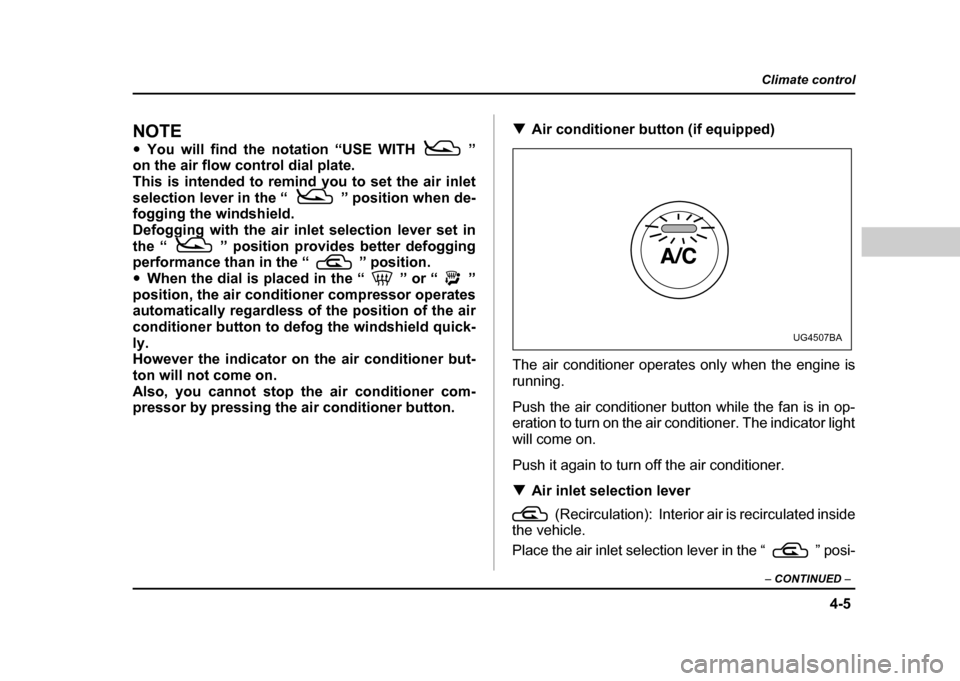
4-5
Climate control
– CONTINUED –
NOTE "You will find the notation “USE WITH ”
on the air flow control dial plate.
This is intended to remind you to set the air inlet
selection lever in the “ ” position when de-
fogging the windshield.
Defogging with the air inlet selection lever set in
the “ ” position provides better defogging
performance than in the “ ” position. " When the dial is placed in the “ ” or “ ”
position, the air conditioner compressor operates
automatically regardless of the position of the air
conditioner button to defog the windshield quick-ly.
However the indicator on the air conditioner but-
ton will not come on.
Also, you cannot stop the air conditioner com-
pressor by pressing the air conditioner button. !
Air conditioner button (if equipped)
The air conditioner operates only when the engine is
running.
Push the air conditioner button while the fan is in op-
eration to turn on the air conditioner. The indicator light
will come on.
Push it again to turn off the air conditioner. ! Air inlet selection lever
(Recirculation): Interior air is recirculated inside
the vehicle.
Place the air inlet selection lever in the “ ” posi-
UG4507BA
Page 200 of 491
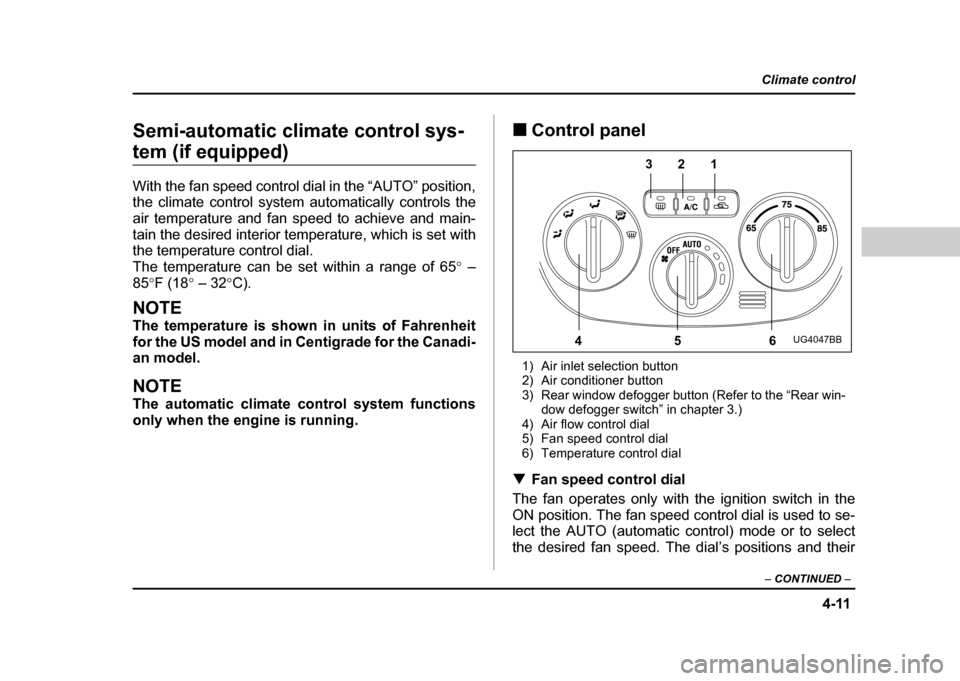
4-11
Climate control
– CONTINUED –
Semi-automatic climate control sys-
tem (if equipped)
With the fan speed control dial in the “AUTO” position,
the climate control system automatically controls the
air temperature and fan speed to achieve and main-
tain the desired interior temperature, which is set with
the temperature control dial.
The temperature can be set within a range of 65 ° –
85 °F (18 ° – 32 °C).
NOTE
The temperature is shown in units of Fahrenheit
for the US model and in Centigrade for the Canadi-
an model.
NOTE
The automatic climate control system functions
only when the engine is running. !
Control panel
1) Air inlet selection button
2) Air conditioner button
3) Rear window defogger button (Refer to the “Rear win- dow defogger switch” in chapter 3.)
4) Air flow control dial
5) Fan speed control dial
6) Temperature control dial
! Fan speed control dial
The fan operates only with the ignition switch in the
ON position. The fan speed control dial is used to se-
lect the AUTO (automatic control) mode or to select
the desired fan speed. The dial’s positions and their
321
456
UG4047BB
Page 201 of 491
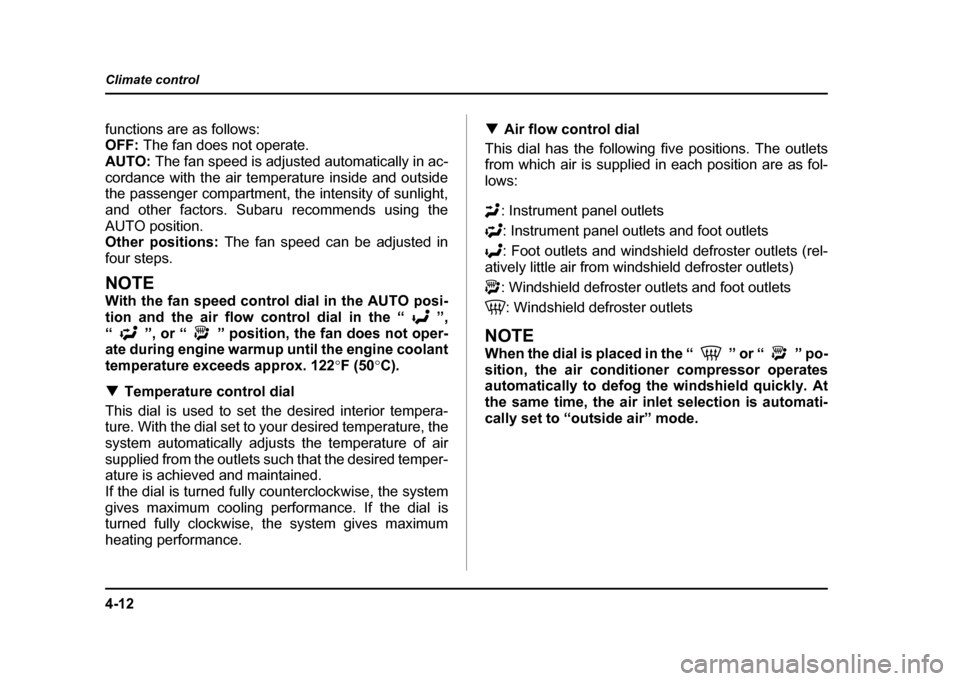
4-12
Climate control
functions are as follows:
OFF:
The fan does not operate.
AUTO: The fan speed is adjusted automatically in ac-
cordance with the air temperature inside and outside
the passenger compartment, the intensity of sunlight,
and other factors. Subaru recommends using the
AUTO position.
Other positions: The fan speed can be adjusted in
four steps.
NOTE
With the fan speed control dial in the AUTO posi-
tion and the air flow control dial in the “ ”,
“ ”, or “ ” position, the fan does not oper-
ate during engine warmup until the engine coolant
temperature exceeds approx. 122 °F (50 °C).
! Temperature control dial
This dial is used to set the desired interior tempera-
ture. With the dial set to your desired temperature, the
system automatically adjusts the temperature of air
supplied from the outlets such that the desired temper-
ature is achieved and maintained.
If the dial is turned fully counterclockwise, the system
gives maximum cooling performance. If the dial is
turned fully clockwise, the system gives maximum
heating performance. !
Air flow control dial
This dial has the following five positions. The outlets
from which air is supplied in each position are as fol-
lows:
: Instrument panel outlets: Instrument panel outlets and foot outlets
: Foot outlets and windshield defroster outlets (rel-
atively little air from windshield defroster outlets)
: Windshield defroster outlets and foot outlets
: Windshield defroster outlets
NOTE
When the dial is placed in the “ ” or “ ” po-
sition, the air conditioner compressor operates
automatically to defog the windshield quickly. At
the same time, the air inlet selection is automati-
cally set to “outside air” mode.
Page 209 of 491
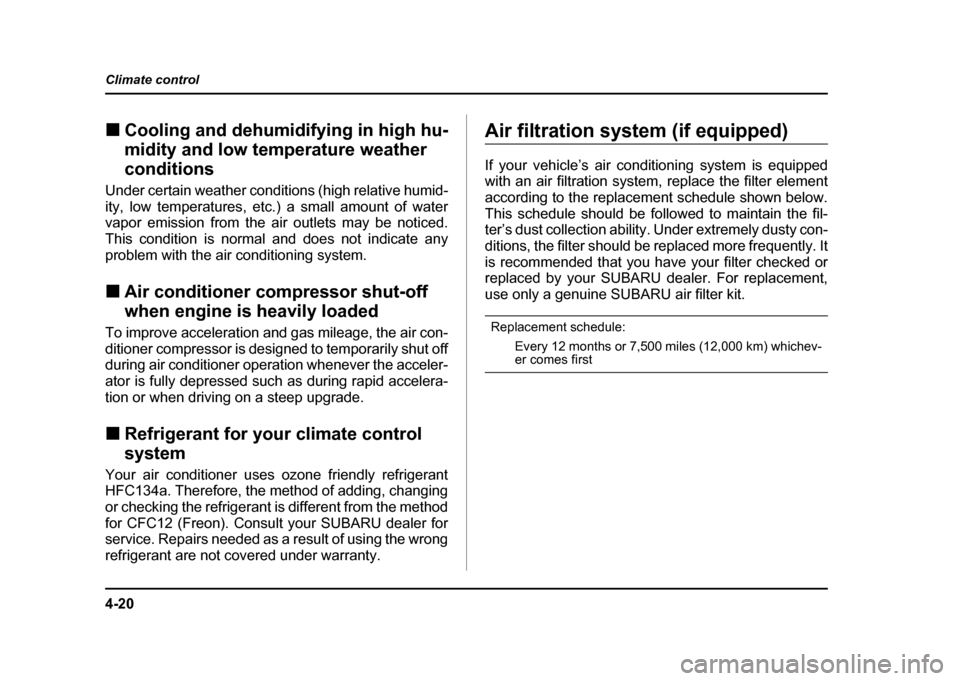
4-20
Climate control
!
Cooling and dehumidifying in high hu-
midity and low temperature weather
conditions
Under certain weather conditions (high relative humid-
ity, low temperatures, etc.) a small amount of water
vapor emission from the air outlets may be noticed.
This condition is normal and does not indicate any
problem with the air conditioning system. ! Air conditioner compressor shut-off
when engine is heavily loaded
To improve acceleration and gas mileage, the air con-
ditioner compressor is designed to temporarily shut off
during air conditioner operation whenever the acceler-
ator is fully depressed such as during rapid accelera-
tion or when driving on a steep upgrade. ! Refrigerant for your climate control
system
Your air conditioner uses ozone friendly refrigerant
HFC134a. Therefore, the method of adding, changing
or checking the refrigerant is different from the method
for CFC12 (Freon). Consult your SUBARU dealer for
service. Repairs needed as a result of using the wrong
refrigerant are not covered under warranty.Air filtration system (if equipped)
If your vehicle’s air conditioning system is equipped
with an air filtration system, replace the filter element
according to the replacement schedule shown below.
This schedule should be followed to maintain the fil-
ter’s dust collection ability. Under extremely dusty con-
ditions, the filter should be replaced more frequently. It
is recommended that you have your filter checked or
replaced by your SUBARU dealer. For replacement,
use only a genuine SUBARU air filter kit.
Replacement schedule: Every 12 months or 7,500 miles (12,000 km) whichev-
er comes first
Page 258 of 491
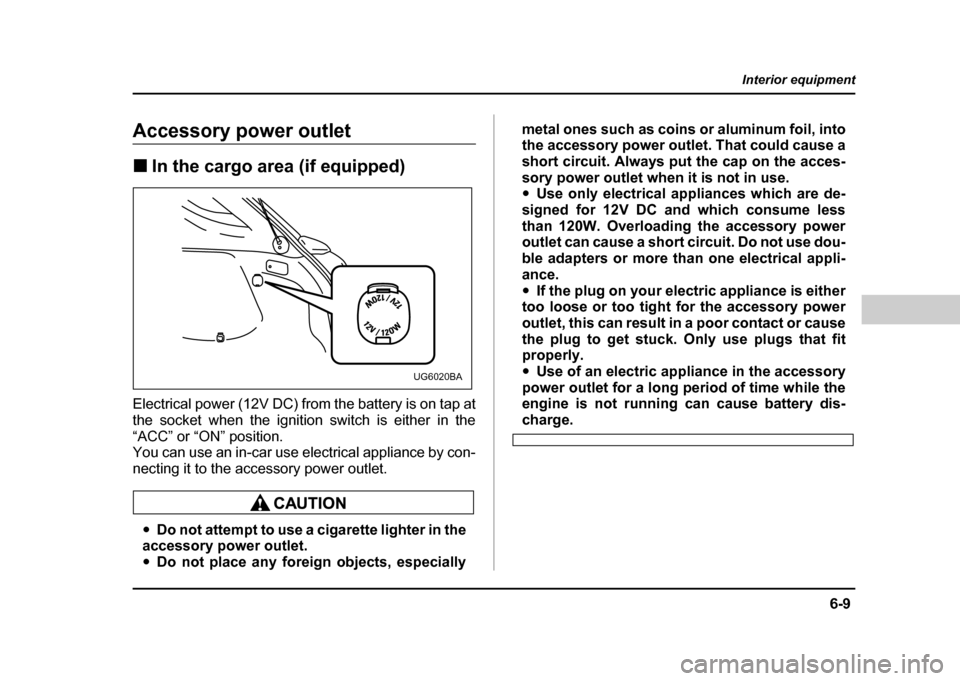
6-9
Interior equipment
– CONTINUED –
Accessory power outlet !In the cargo area (if equipped)
Electrical power (12V DC) from the battery is on tap at
the socket when the ignition switch is either in the
“ACC” or “ON” position.
You can use an in-car use electrical appliance by con-
necting it to the accessory power outlet.
" Do not attempt to use a cigarette lighter in the
accessory power outlet. " Do not place any foreign objects, especially metal ones such as coins or aluminum foil, into
the accessory power outlet. That could cause a
short circuit. Always put the cap on the acces-
sory power outlet when it is not in use. "
Use only electrical appliances which are de-
signed for 12V DC and which consume less
than 120W. Overloading the accessory power
outlet can cause a short circuit. Do not use dou-
ble adapters or more than one electrical appli-
ance." If the plug on your electric appliance is either
too loose or too tight for the accessory power
outlet, this can result in a poor contact or cause
the plug to get stuck. Only use plugs that fit
properly. " Use of an electric appliance in the accessory
power outlet for a long period of time while the
engine is not running can cause battery dis-
charge.
UG6020BA
Page 261 of 491

6-12
Interior equipment
"
Use of an electric appliance in the socket for
a long period of time while the engine is not
running can cause battery discharge." Before driving your vehicle, make sure that
the plug and the cord on your electrical appli-
ance will not interfere with your shifting gears
and operating the accelerator and brake pedals.
If they do, do not use the electrical appliance
while driving.
If the socket has been used for electrical appliances,
damage may have been done to the internal mecha-
nism that causes a cigarette lighter to “pop out” after
its element has been heated. For that reason, a ciga-
rette lighter, even if it is a genuine part, should not be
used in the socket. If you want to use the socket for a
cigarette lighter again, or to protect your purchaser be-
fore you sell your car, have your SUBARU dealer re-
place the socket with a new one.
Ashtray
1) Push
2) Pull
To open the ashtray, pull the lid out.
Fully close the ashtray after using it to help reduce re-
sidual smoke.
To remove the ashtray for cleaning, open it and pull it
out while pushing the inner plate down.
2 1
UG6509CB
Page 270 of 491

7-1
7
Starting and operating
F uel .. ... ... ... .. ... ... ... ... .. ... ... ... ... ... .. ... ... ... ... .. ... ... 7-2
F uel re quire ments ..................... ..................... ... 7-2
Fuel filler lid and cap ........................................ 7-4
State emission testing (U.S. only) ............... 7-7
Preparing to drive ......................................... 7-9
Starting the engine ....................................... 7-9 Manual transmission vehicle ........................... 7-9
Automatic transmission vehicle ...................... 7-10
Starting the engine during cold weather below −4 °F ( −20 °C) ......................................... 7-10
Starting a flooded engine ................................. 7-11
Stopping the engine ..................................... 7-11
Manual transmission – 6 speed (WRX-STi) 7-12 Selecting reverse gear ...................................... 7-12
Shifting speeds ................................................. 7-13
Driving tips ........................................................ 7-14
Manual transmission – 5 speed (except WRX-STi) ...................................... 7-15Shifting speeds ................................................. 7-15
Driving tips ........................................................ 7-17
Driver’s Control Center Differential (DCCD) (WRX-STi) ..................................... 7-18Auto mode ......................................................... 7-18
Manual mode ..................................................... 7-19
Temporary release ............................................ 7-21
Automatic transmission ............................... 7-21 Selector lever for automatic transmission ..... 7-22
Shift lock release .............................................. 7-26
Limited slip differential (LSD) (if equipped) 7-27 Power steering .............................................. 7-28
Braking ........................................................... 7-28
Braking tips ....................................................... 7-28
Brake system .................................................... 7-29
Disc brake pad wear warning indicators ........ 7-29
ABS (Anti-lock Brake System) ..................... 7-30 ABS system self-check .................................... 7-30
ABS warning light ............................................. 7-31
Electronic Brake Force Distribution (EBD) system ........................................................ 7-32Steps to take if EBD system fails .................... 7-33
Parking your vehicle ..................................... 7-34 Parking brake .................................................... 7-34
Parking tips ....................................................... 7-35
Cruise control ................................................ 7-37 To set cruise control ........................................ 7-37
To temporarily cancel the cruise control ....... 7-39
To turn off the cruise control ........................... 7-40
To change the cruising speed ......................... 7-40